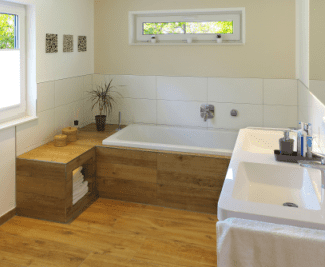Everything You Should Know Before Installing Wood Flooring in Your Bathroom

Below, Mallory Micetich, home care expert at Angi, explains what types of wood perform best in high-moisture areas and whether hardwood really can work with condensation. Unfortunately, not all the news is good, though we have plenty of ways for you to make good on your bathroom vision. Here’s everything you should know before installing wood floors in your bathroom.
Advantages of Wood Flooring
Often, homeowners are drawn to wood flooring for its warm and cozy look. It can instantly elevate a space and bring a lived-in quality that just can’t be replicated with many other flooring types. But beyond aesthetics, Micetich points to more practical reasons why it might be appealing. “Wood can be a great choice for most of your home. It is durable, long-lasting, low-maintenance, and is available in a wide range of price options,” she says. It’s a compelling argument, but there’s more than meets the eye when it comes to whether this material is up for the job.
Can Wood Flooring Be Used in Bathrooms?
When considering whether wood flooring can be used in a bathroom, it’s important to note the features and environmental factors of the space that could potentially compromise the material. In particular, factor in moisture and humidity. For these reasons, hardwood is not an advisable flooring option for your bathroom. “Wood is a porous material that tends to absorb moisture and warp over time,” warns Micetich. “If you install hardwood floors in your bathrooms, there’s a good chance you’ll need to replace them due to water damage.” Thankfully, there are plenty of ways to get the look with products that are meant to stand up to the elements.
The Best Wood Flooring Alternatives for Bathrooms
Before we squash your bathroom flooring goals, know that all isn’t lost. In fact, there are still plenty of look-alike options that can help you get the look of hardwood. “If you want the look and feel of hardwood in your bathroom, consider installing engineered wood or tiles that look like wood,” suggests Micetich. “Engineered wood is relatively inexpensive and water-resistant, which makes it a better choice for bathrooms and other damp areas in your home, and tile is always a great option for bathrooms.”
Due to its increased popularity in recent years, wood-look tile options have exploded. You can now find plenty of options that range in price and suit just about any look. Plus, they’re meant to live in high-moisture environments like bathrooms without issue. Ceramic and natural stone are also worth considering, but Micetich points to vinyl as one of her favorite wood flooring alternatives for the bathroom. “Luxury vinyl flooring, or LVP, is a great alternative to wood. It’s affordable and water-resistant, making it ideal for damp spaces like bathrooms,” she says. “LVP comes in many different colors and styles, so you can customize it to match your home’s aesthetic.”
No matter which wood flooring alternative you opt for, you’ll be glad you researched options that are best suited for your space so you won’t find yourself with warped panels or other unsavory side effects of a material not best suited for the bathroom. Give yourself time to find a wood flooring alternative that best fits your aesthetic goals and you’ll have a foundation for your space that you’ll love for many years to come.
Source: Better Homes & Gardens
Paying Too Much For Insurance?
Get a FREE quote to insure your rental properties for less.















 Accessibility
Accessibility